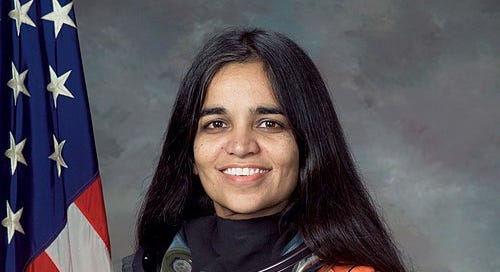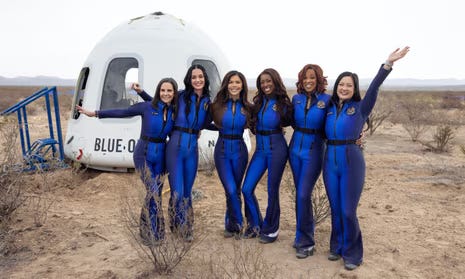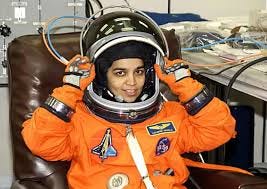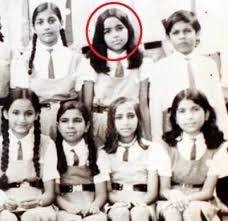the woman who DID make space empowering
kalpana chawla went from a small indian city to up in space, inspiring a generation of girls to find meaning in the great beyond
(welcome to bimbo university: extra credit! where every week i spotlight a woman or queer person from history that i feel doesn’t get their flowers enough.)
unless you’ve been blissfully offline this week (lucky) it’s hard to miss the news and discourse surrounding the first all-female space flight. Jeff Bezos’ space tourism company, blue origin, sent a crew comprised of his girlfriend, Lauren Sanchez, Oprah’s bestie Gayle King, filmmaker Kerianne Flynn, scientists Aisha Bowe and Amanda Nguyen, and of course - the woman who unfortunately created the best pop song of all time, teenage dream - Katy Perry. the flight was criticized for being girlboss feminist, a feminism that measures women’s success within a capitalist framework and proximity to men. i think about a joke by Andrew Schulz - a conservative Trumper comedian - unfortunately making an interesting point asking, “why are feminist women trying to be the men they hate?”
anyway, the flight was not the vibe. when you’re in a decade where the buzzword is authenticity, the biggest crime you can commit is be contradictory. the blue origin flight was marketed as empowering towards women while Trump’s budget cuts led to the firing of numerous nasa staff, including dei chief Neela Rajendra. the journey - where one seat costs at least $150,000 - was marketed as a way to help us learn more about earth where half of the population lives on less than $6 per day. want to learn more about earth? fix the problems we have here.
of course nothing in life is black and white - aerospace engineer, Aisha Bowe, and bioastronautics researcher, Amanda Nguyen, did make history and used the short 11-minute trip to conduct important research. yet they had the bad fortune of sharing their hard-earned journey with someone who got it through her male billionaire partner who has actively contributed to climate change and numerous human rights violations.
yet space can teach us about life on earth. learning things from climate patterns to how the absence of gravity can further medical science - all of that is essential knowledge that only brilliant, accomplished astronauts could teach us. each year, nasa selects just 10-12 people for its astronaut program from a pool of 12,000 applicants so you’ve got to be amazing, especially when you didn’t have access to specialized training programs that an astronaut from a richer background could’ve afforded.
while people rightly criticize a vain project, i hope that we don’t fall into the trap of critiquing any form of space travel and astronauts. and so i thought it would be the perfect time to bring up Kalpana Chawla.
i was only 9 years old when Kalpana Chawla took off on her second space flight in january 2003. i don’t remember anything about it, just that my parents were talking about it nonstop. not just because of representation - although seeing a woman from a relatively-unknown indian city traversing the last frontier is incredible - but because of all her passion and hardships that led her to this moment.
kalpana chawla was born in 1962 in karnal, a small city in the indian state of punjab. her parents were punjabi hindus who migrated to the city during the 1947 partition, where the british divided the country’s hindu population into india, and muslim population into pakistan - a divide that ran through established communities and led to 10 million people being displaced. in addition to its history, punjab’s location on the india-pakistan border makes it a significant transit route for drug trafficking. almost 75% of punjabi youth is using drugs other than alcohol and tobacco. it’s not the easiest place to grow up.
equally hard is pursuing an extremely specialized education, especially as a girl in the 1960s. kalpana had first shown interest in flying after seeing a plane at the age of 3 - but family members told her that studying planes was for boys. still, she knew what was best for her. Kalpana graduated near the top of her class in 1976 and went on to take aeronautical engineering classes at the punjab engineering college. she was the only woman to be in this program. after her classes couldn’t get anymore specialized, she traveled to the united states in 1982 to get her masters, against the wishes of her father.
i don’t think y’all realize the amount of strength it takes to defy the wishes of your indian father. this is a culture where making decisions on your own is seen as incredibly selfish, no matter your gender but especially as a woman. and the pressure eventually gets internalized, where you consider how much your parents gave up for your happiness and the only way to make them happy is to pay it forward by giving up yours! even if you do have parents who wholeheartedly support your dreams, the voice in your head changes to, well damn, might as well show my gratitude by doing what they want. the cycle is hard to break out of.
kalpana found success in america. she received her masters’ degree at UT arlington in 1984, and then her phD in 1988 at UC boulder. it was in colorado she gained her commercial flying license to fly airplanes, gliders, and seaplanes. all of this by age 26! what was i doing at age 26? finally coming to terms with the fact that my 3-year situationship maaaybe doesn’t like me. an accomplishment of its own!
after her phD, Kalpana began working at nasa’s ames research center to study how an aircraft can takeoff and land vertically, knowledge that’s necessary for when pilots are dealing with short runways. she later joined a nonprofit research organization, working on the problems that could arise when multiple objects are moving in the air. Kalpana studied bharatnatyam dance in her free time (what free time) and eventually in 1994, started training as an astronaut at nasa’s johnson space center. really love how she was the perfect indian daughter without being the perfect indian daughter. as my dad - and by extension, most modern immigrant parents - have said, do what you want but be the best in that field.
so you thought Kalpana’s research was hard to understand? buckle up because training for space is a whole different ball game. not only do you have to incredibly smart but you also have to be a human machine. a masters’ degree from a stem field is required, as is 1,000 hours in pilot training. you must be able to swim three lengths of a swimming pool in a flight suit and boots, tread water for ten minutes, and simulate underwater escape training for when a capsule lands in the ocean. you have to spend a long time isolated to test how well you handle stress and boredom. in some instances, you may be spun around in a human centrifuge to simulate take off and re-entry. and if your mission involves the international space station, you have to be fluent in russian.
but of course, you can bypass all this and buy a ticket on the blue origin.
Kalpana was one out of 19 candidates selected to be an astronaut, out of over 10,000 applicants. her first space mission was in 1997 on the space shuttle columbia where she served as a backup flight engineer during takeoff.
during this mission, Kalpana was responsible for releasing a small satellite to study the outer layer of the sun. she used the space shuttle’s robotic arm to release the satellite, but her control screen didn’t show that the arm had latched on to it properly. technicalities aside, the arm accidentally hits the satellite, causing it to spin and becoming unable to catch. two astronauts had to go on a spacewalk - an expensive and dangerous task - to retrieve it. the outer layer never got studied and the mission lost a lot of money for that. she was criticized by other members of this handling, and i can’t imagine how tough that must have been. no actually i can, because when you’re the only woman - and that too, non-white - in a crew full of men it’s impossible not to screw up and begin internalizing all the terrible stereotypes people must be thinking of you.
Kalpana didn’t let the error of her first space mission let her down. in fact, she was reenergized and wanted to pay it forward. each year since 1998, Kalpana’s high school in punjab sent two girls to the united space school in houston for space education. Kalpana would invite them into her home for an indian dinner. her passion for space was endless and she truly wanted young women to experience it.
Kalpana was selected for another mission in 2000. the mission was delayed for three years due to maintenance and the discovery of cracks in the shuttle engine liners. Kalpana and six other crew members finally take off in january 2003. the flight my parents were talking about.
on this mission, she and her crew conducted 80 experiments, including gravity’s effects of human muscle, lungs, and bones. this research was essential to learning more about osteoporosis and bone density, as well as respiratory treatments. she also studied how cells grow in space, knowledge that can lead to a better understanding of cancer. another experiment was about how flames move in zero-gravity, something that can be used to improve fire safety systems in buildings, airplanes, and factories. this mission was about a month long, with the crew working in two shifts - 24/7.
on february 1, 2003, the columbia space shuttle was set to begin its descent back to earth. upon reentry, a briefcase-sized piece of insulation had broken off from the engine liners during launch - one of the earlier problems that had initially delayed the flight reappearing. the shield that protects the shuttle from heat upon re-entry was damaged, causing columbia to burst into flames. Kalpana and her six crewmembers all tragically passed that day.
“when you look at the stars and the galaxy, you feel that you are not just from any particular piece of land, but from the solar system.”
-Kalpana Chawla, 1998
i remember the news of the columbia explosion being everywhere but i was too young to understand it. now after researching it i’m just angry. south asian women get so few role models in this world who are breaking tradition and cultural norms, defying their family’s wishes, let alone being among the few human beings in the world to ever make it into space. and the one who made it so far suffered such a disastrous end. the worst voice in my head says that’s what happens to women who dare be brave. the best voice in my head says that’s exactly why i should keep going, because there are so few of us. it’s complicated!
my best friend has worked at a strip club for more than five years and has endured the worst of male impulses, countless stigma from friends and family members, and a forever-fucked sleep schedule gained from working 10pm-6am shifts. she told me a story about paying the house fee to perform at the club, something strippers regularly have to do because they make back the money in tips (sometimes). when she came to the pole, there were a bunch of women from recreational pole-dancing classes taking up that space. they’d pay to learn a few cool tricks, get the attention but none of the repercussions.
i thought of that story when writing about Kalpana and the blue origin women. their accomplishment was just the fact that most of the passengers had money. they didn’t have to endure a parent who said they should have a different career, didn’t have a school who said no opportunities exist for women in aerospace engineering, didn’t have to endure thousands of hours of flying lessons and even more hours of rigorous education and then loads of athletic training. i’m sure they had obstacles, but in the end, they had a few thousand dollars and an attachment to a man who really matters.
and so while that space story wasn’t all that empowering, Kalpana’s was because what she had to overcome. if you have a couple thousand dollars you can blow on 11 minutes of space, go ahead. just don’t act like you’re making some huge step for young women. because there are women who are actually doing that, and if they’re not losing their lives then they’re losing their jobs.
sources: wikipedia, space.com, nasa.gov, airandspace, theguardian









when the narrative switches to "but of course, you can bypass all this and buy a ticket on the blue origin." ughhhhhhhHHHHHHHHH re-ignition of anger
Thank you for sharing this story. It's really powerful, and the pull quote and image you shared of her in space are really beautiful.